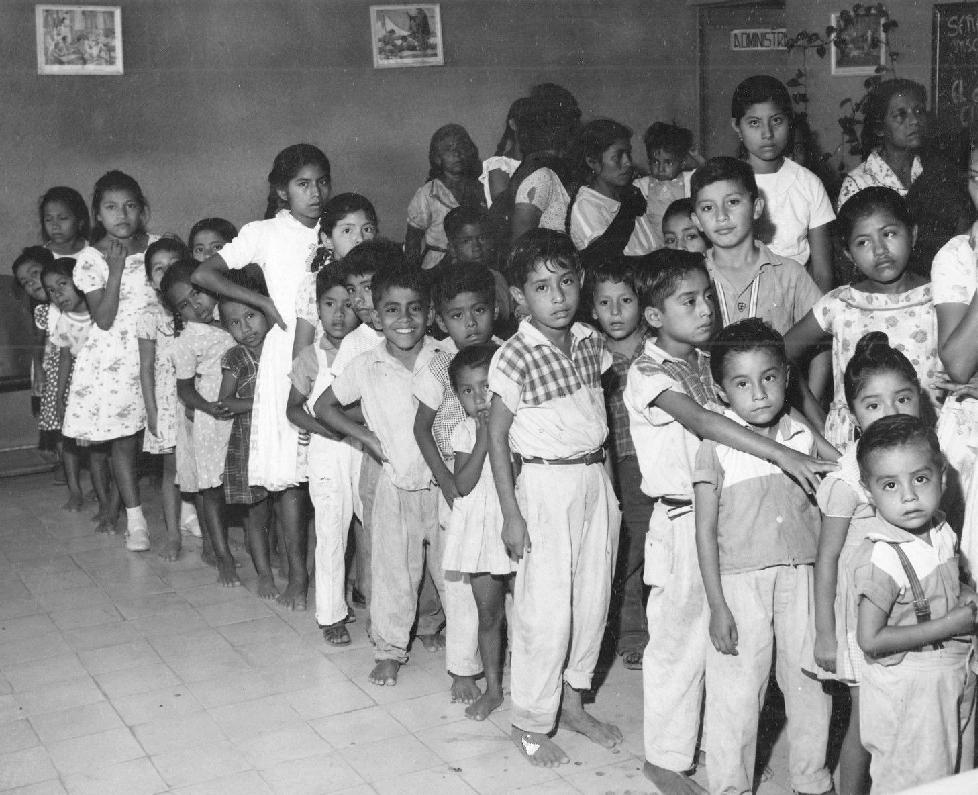
United Nations Agencies: The United Nations International Emergency Children's Fund (UNICEF)

Figure 1.-- Child survival is one of the key mossions of UNICEF. Thus the agency supports child survival eeforts. Hre publkic heath profams are important, epecially programs addressing mothers and childrem. Here is one in Mexico. The 1965 UNICEF press caption read, "Basic Health/MCH: School children line up at maternal and child health centre in Pochutla [Oaxaca] on a regular visiting day. In rural Mexico many communities have access to modern medical care. The United Nations Children's Fund (UNICEF) is aiding government efforts to improve standards of health by assisting programs in maternal and child health, sanitation, and health eduction. UNICEF provides euipment and drugs for health centres as well as teachinh material and stipends to help train dictors, nurses, sanitariums and commuity developmnt workers who promote sanitation and home-making imprivemnts at the village level." Photographer: Ilsa Kraus.
|
|
Another important U.N. agency working with children is United Nations International Emergency Children's Fund (UNICEF). It was one of the first projects of the newly created United Nations. The General Assembly created UNICEF (December 11, 1946). Its initial mission was to provide emergency food and healthcare to children in countries devastated by World War II. UNICEF proved so sucessful that the United Nations decided it was essential and made it a permanent part of the United Nations System (1953). Although many controversies surround various U.N. agencies, UNICEF is the single most respected and popular agenciey in the U.N. System. Its name was shortened, but it has continued to be known by acronym based on this previous name because it was such a popular agency and the original acronym had become so well known. UNICEF today works in 190 countries and territories. UNICEF sees its mission as saving children's lives, defending their rights, and helping to fulfil their potential, from early childhood through adolescence. UNICEF's progrms include: child protection, child survival, education, emergencies, gender, innovation, supply and logistics, and research and analysis. UNICEF relies on contributions from governments and private donors. UNICEF's total income for 2015 was US$5bbillion. Governments contribute two-thirds of the organization's resources. Private groups and individuals contribute the rest through national committees. One charity watchdog NGO estimates that Over 90 percent of UNICEF revenue is distributed to program services. [Charitynavigator] This is a very high proportion and unusually efficient for any charity, let alone a U.N. agency. While UNICEF has a diverse range of activities, mot of the programs emphasize developing nationmal capabilitie to promote the health and well-being of children. UNICEF was awarded the Nobel Peace Prize (1965) and the Prince of Asturias Award of Concord (2006).
CIH

Navigate the Children in History Website:
[Return to the Main United Nations agency page]
[Return to the Main United Nations page]
[Return to the Main Internation Organization page]
[Return to the Main history page]
[Introduction]
[Biographies]
[Chronology]
[Climatology]
[Clothing]
[Disease and Health]
[Economics]
[Geography]
[History]
[Human Nature]
[Law]
[Nationalism]
[Presidents]
[Religion]
[Royalty]
[Science]
[Social Class]
[Bibliographies]
[Contributions]
[FAQs]
[Glossaries]
[Images]
[Links]
[Registration]
[Tools]
[Children in History Home]
Created: 7:22 PM 6/7/2016
Last updated: 7:22 PM 6/7/2016



